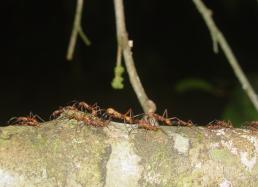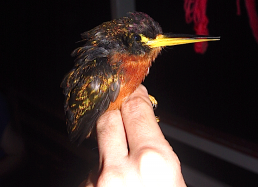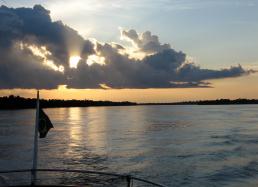Amazonian Bird Facts
In North America, we're probably most familiar with flocks made up of one species of bird, such as American Crows, Canada Geese, etc. But in Amazonia, mixed flocks are common, perhaps because different species foraging together have better luck spotting predators and finding food.
Mixed-species flocks often specialize in specific areas of the forest and in certain foods. For example, understory flocks typically feed on arthropods (insects, spiders, etc.), whereas canopy flocks may be fruit eaters or insects specialists. And within each group, individual species often focus on certain niches. Some insect eaters sort through dead leaves for food, while others forage along tree trunks. Some glean along branches, while others look within Bromeliads ("air plants").
Migratory Instincts
Food resources have affected Amazonian bird evolution in other ways, too. For example, in North America, we often mark the seasons by watching for the arrival or departure of our favorite bird species that migrate long distances to find food throughout the year. But scientists think that the majority of Amazonian birds haven’t evolved with the instinct to migrate because these natives can easily find food year-round in their lush, equatorial environment. Brazilian Amazonia alone harbors more than 1,300 resident bird species!
Surprisingly, even with such a vast pantry, Amazonian bird populations often have incredibly restricted geographic ranges. Many species won’t even fly across a river to find food. Why? One explanation is that these birds evolved beneath the dense shade of the rainforest canopy. Crossing a wide-open river not only makes them vulnerable to predators, but also exposes them to uncomfortably bright sunlight. Another reason may be that they simply haven't evolved to be physically capable of flying such long distances without resting on a perch.
Amazonian Riverways & Evolution
A bird that avoids flying over a waterway may seem strange to us, but consider that some Amazonian rivers are much wider and more dynamic than those of North America. They can change their course, depth, and width from year to year. For example, during the rainy season, the Amazon River can swell to more than 24 miles (39 kilometers) wide. Even during the dry season, it still measures around 7 miles (11 km) in width. That’s seven times wider than the Mississippi—North America's widest river!
Rivers are one factor that can act as a catalyst for evolutionary changes in the Amazon. It’s not hard to imagine that these complex waterways can act as barriers not only to birds, but to many other animals as well. Exactly how rivers have influenced the distribution and evolution of Amazonian animals is still not completely understood. But it has long been known that these sometimes dynamic waterways have divided populations so that new species have evolved over time on opposite banks—an important factor to consider when creating protected areas and setting priorities for conserving genetic diversity in the region.



